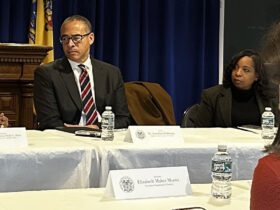 Voting, a basic fundamental right, a cornerstone of democracy, is not easy. During each election, many Americans complain about the complexity of the voting process. In fact, our nation’s intricate and complicated voting system may contribute to the consistently low voter participation. And so, let me educate you and give you some pointers to ensure a smooth Election Day.
Voting, a basic fundamental right, a cornerstone of democracy, is not easy. During each election, many Americans complain about the complexity of the voting process. In fact, our nation’s intricate and complicated voting system may contribute to the consistently low voter participation. And so, let me educate you and give you some pointers to ensure a smooth Election Day.
Step 1: Research the two major political parties.
Our nation is pretty much split into two parties: Democrats and Republicans. Most government officials will identify themselves as one party or the other. Thus, it is crucial to understand the overall views of each party on a wide range of issues. While perspectives have changed throughout American history, there are clear differences between the two. For instance, recently, Democrats have largely defended the legality of abortion while most Republicans have opposed it. Democrats also support decreased military spending while Republicans do not. Of course, not everyone thinks the same, and there are those who disagree with some of their own party’s views (discussed in-depth in steps 3 and 4). Nevertheless, a clear, full understanding of both parties will give you information on where you stand.
Step 2: Familiarize yourself with smaller parties.
While Democrats and Republicans remain the majority of America, there are several smaller, third parties, including the Green, Constitution, and Libertarian parties. The Green Party is a grassroots national party that focuses on environmentalism, nonviolence, social justice, and sustainability. Notable supporters include 2016 presidential candidate Jill Stein and current 2020 presidential candidate Howie Hawkins. The Constitution Party is a far-right national party that supports a strict interpretation of the Declaration of Independence, the Constitution, and the Bill of Rights while aiming to implement Biblical practices into the government. A notable candidate is Howard Phillips. Finally, the Libertarian Party is the largest third party in America. Libertarians are pro-civil liberties and mainly support the rights of freedom. Furthermore, there are independent candidates who choose not to identify themselves with the political parties present in America. Nevertheless, these smaller parties and candidates have continually failed to make strides within our government as only Democratic and Republican presidents have ever been elected.
Step 3: Know where you stand.
Are you a Democrat or a Republican? Do you stand far left or far right? Are you more moderate? These are all questions to ask yourself to figure out your specific perspectives. After completing your research on the various parties, form your own opinions based on the various issues that each party supports. While hearing others’ perspectives may be informative, try not to base your beliefs solely on what friends, families, or the general public say. Just because your state leans toward a particular party does not mean that you must share those same views. Also, make sure to identify yourself within the party. In other words, you may be an extreme or more moderate supporter of Democrats or Republicans. Perhaps you consider yourself a Conservative but you don’t think the government is doing enough to protect our environment. Or, you want some kind of government regulation in the economy. If so, you may be a moderate Republican. Doing this type of in-depth research is crucial because not all Democrats will agree with each other and not all Republicans will do the same. Knowing where you stand on issues instead of knowing what general party you belong to will help you choose more wisely on an election ballot.
Take this quiz to see where you stand on the political scale:
https://www.isidewith.com/political-quiz
Step 4: Research the important differences between candidates within the same party.
Despite the common misconception, not all Democrats, Republicans, or other parties think alike. In fact, candidates in each political party may have significantly different ideas and proposals. Take, for instance, former 2020 presidential candidate Andrew Yang and current candidate Joe Biden. Both Yang and Biden identify as part of the Democratic party, but they have vastly different views on various topics. Yang argued that the cost of college should not be free while Biden proposed to make two years of community or technical college free. Yang actually shared very diverse perspectives compared to other Democratic candidates. For example, he proposed a universal basic income for all Americans. No other Democratic candidate shared a similar view. Clearly, not all candidates from a particular party think the same. In fact, it’s nearly impossible that all your views will match up with the politicians from your preferred political party. Your views may line up with candidates from opposing parties instead. It is crucial to research and educate yourselves on the plans and policies of each candidate rather than a party itself. Parties are merely groups of people who are placed together based on overall similar goals. You must consider each candidate without regard to party identification first in order to gain a holistic perspective of an election.
Furthermore, consider the candidate’s backgrounds. Research their childhood, religion, education, past occupations, and family life. Perhaps someone who has a similar background as you will share similar views and will, therefore, focus on direct and immediate issues that pertain to you during his or her presidency. If you focus on the federal government’s involvement with our economy, maybe you should support Trump and his knowledge in business and entrepreneurship. On the contrary, maybe you grew up with humble beginnings and a president with a comparable childhood will likely understand the struggles of the working class.
Step 5: Understand the danger of straight-ticket voting.
Straight-ticket voting is when voters choose all Democrats or all Republicans in an election ballot. However, especially based on the numerous differences between candidates representing a single political party highlighted in Step 4, I do not recommend straight-ticket voting. Some argue that this kind of voting entices more voter participation because voters will enter and exit booths much quicker. However, these advocates fail to consider that, first of all, voter participation is already low, and there are more significant factors that contribute to this statistic. Second, straight-ticket voting promotes comfort over action. It is essential that voters understand and know the people they are voting for. A Republican presidential candidate will likely not share the same views as every other Republican official who appears on the ballot. Some areas provide the option of straight-ticket voting, but it further divides our country into two parties and discourages the education and knowledge of representatives in our government.














